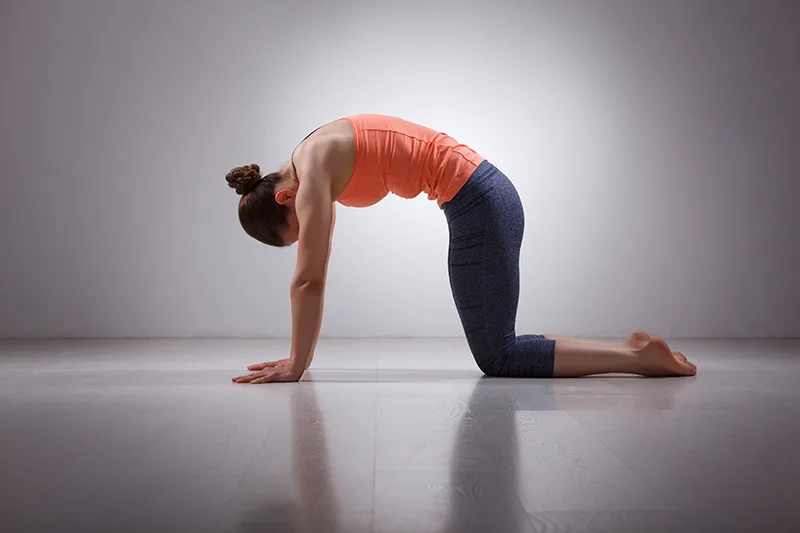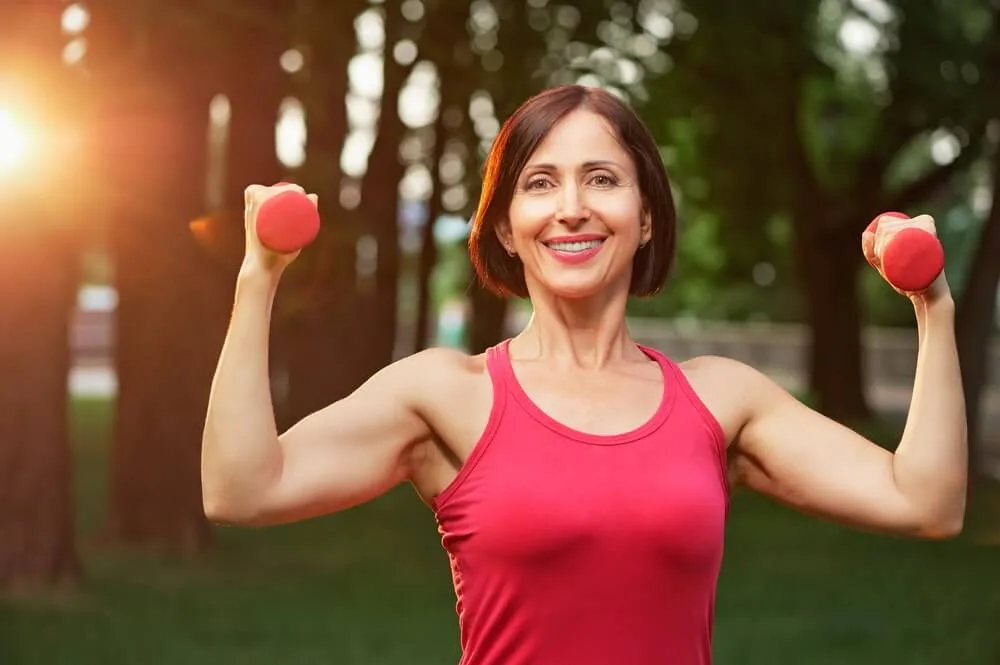The Hundred is a classic Pilates mat exercise. It also one of the most challenging and dynamic moves in the mat repertoire. You will often perform the Pilates 100 exercise at the beginning of a Pilates class as a dynamic warm up and to engage the various systems of the body.
Aside from getting the blood pumping, this exercise has many other benefits. These include, improved circulation, increased spinal mobility, better breathing habits and stronger abdominals.
However, if you’ve been Googling “How to avoid neck tension in the Pilates Hundred” then you’ll know this exercise has its downsides. And it’s true, performing the hundred can result in aches and pains in the neck and shoulders. These complaints are especially common in Pilates beginners.
Of course, if you have constant neck pain or you believe it is getting worse then seek advice from your health care provider. But if the discomfort is only due to weaknesses, inflexibility or performing the exercise incorrectly then a few simple adjustments can make all the difference.
How to do the Pilates Hundred Exercise?
The Hundred is a move that requires coordination of breath and movement. Control and precision are two other important features of this exercise.
For those of you unfamiliar with the Pilates hundred already, here’s how to execute it.
The first step of the Pilates hundred exercise involves getting into the right position. From supine (flat on your back) on the mat find table top legs position. This is when the knees are bent so that the thighs are perpendicular to the floor and the shins are parallel to the floor.
The next step involves reaching your fingers towards your toes. As you do so, your head, neck and upper spine should curl up into a “C” shape. And they stay there for the duration of the exercise! At this point your arms will be hovering a few inches off the ground.
Finally, straighten your legs so that they are suspended above your mat. You can lower them towards the ground for greater challenge to the abdominals or higher for less challenge.
And now for the exercise itself.
The Hundred is named after the number of beats your arms make during the exercise. So, once you find the starting position, start to pump your arms up and down. As you do so, sync these movements with your breath.
There is a specific breath pattern in this exercise. And it goes: inhale for five seconds, exhale for five seconds. Repeat inhaling and exhaling this way ten times and there you have it: the Pilates Hundred.
Common Pilates 100 mistakes to avoid
There are a few common errors that can typically be made when learning how to execute the hundred – making it both harder and less effective than it should be!
Firstly, people may mistakenly try to keep their chest open and shoulders wide instead of allowing the shoulders to curl forward. This works against the need for the upper body to curl forward and makes it much harder to do the exercise.
Secondly, poking your chin forwards will mean that you are not engaging the deep muscles of the neck that help to stabilise your head and neck. You are then overworking the large superficial muscles at the front of the neck and when these are doing all the work it creates a lot of tension!
Thirdly, forcing the lower back into the floor. Often this is accompanied by a prominent bulging of the lower abdominals and holding the breath. This can get in the way of your curl up and mean that you are not using your abdominals to help lift the weight of your upper body – and can add extra load to the neck muscles.
Fourthly, timing is everything, picking up your head slightly too late means that your head is a heavy load that is left behind the rest of your body. This can add a lot more tension to the exercise.
Tips to improve your Pilates 100
Finding the “flexed” (rounded) upper spine shape of the Hundred can be difficult. It’s what often leads to a tense and sore neck during the Pilates 100 exercise.
When the neck works harder than it should be it usually means it is not being supported by the surrounding structures. Weak abdominals, a weak back or a stiff spine are often the reason for this. To target some of these problem areas, try Yoga poses like Cat Cow (pictured below) and this mid-spine mobilisation exercise.
There are also a few simple techniques you can try to reduce your chances of neck pain in the Hundred.
First, find the table top position in the first step outlined above. Then, create a “hammock” with your hands by lacing your fingers together.
Slide this behind your head to the base of your skull. Your head is heavy – about 10 pounds – and it needs support, so let your hands and arms take the weight of your head. Now bring your elbows into your peripheral vision.
From here, take a deep breath in and then, on a slow breath out from an open mouth (rather than pursed lips) lift your head up and with it your upper spine off the mat to find the desired “C” shape.

How to avoid neck tension with The hundred pilates exercise’
Allow your head to be remain really heavy in your hands throughout the exercise.
As you move, visualise your ribs sliding down towards your pubic bone. At the same time, imagine lengthening through the top of head.
Looking up can feel like a natural response during this exercise. But this will only cause you to strain your neck more. Instead, keep your gaze between your legs. Imagery can be helpful in Pilates, so why not try imagining there is an orange between your chest and chin. This should keep your chin lifted and neck elongated.
If you feel your head and neck craning forwards during the exercise, imagine your eyes are marbles and they have rolled to the back of your head. This image can assist with keeping your head in line with the rest of your spine.
And finally, although your abdominals are obviously engaged here, don’t forcibly scoop them. Instead, allow your ribs to just settle down (rather than pop up) to support you. In doing so, you should create a feeling of ease in the body that frees up your head and neck.
Practise this movement to prepare your body before attempting the full exercise. Do so by lowering the head to the ground then lifting the head, neck and upper spine several times.
Then, when you feel stable in your curled position, reach your arms down to either side of your body to find the Hundred starting position.
Modifying the Pilates Hundred
Neck still hurting? There are various ways you can modify the Hundred. For example, you can extend your legs but keep your hands behind your head.
You can use a magic circle in much the same way. Simply take it into both hands, slide it behind the neck and allow your head to rest on it. From here you can extend the legs and avoid straining the neck.
Or, you can execute this exercise with legs extended and arm pumping but with your head flat on the mat.
Finally, if all of this is too challenging, keep your feet flat on the mat while you lift and lower the head and upper spine. This followed up with Femur Arc and Deadbug exercises will mobilise the spine and strengthen the abdominals safely.
If you are struggling with any of this why not book our new client offer.
Conclusion
So there we have it – the Pilates Hundred exercise! It’s a challenging exercise that eludes many people. However, you can master the Pilates Hundred by breaking it down into the different parts of the exercise and working on those, gradually building up to the full exercise.
This should help you to eventually be able to perform the exercise comfortably and safely, whilst still getting the benefits along the way. You can make modifications if you need to, which can accommodate any neck discomfort.
However, if you are still struggling to make this exercise work for you, you may wish to get some expert in person tuition, as nothing beats real time feedback and hands on guidance.
Join us at Complete Pilates
If you are struggling with performing the Pilates 100 and you’re based in London, why not book our new client offer? Join us for Pilates in Angel, Pilates in Chelsea and Pilates in London City to find out more about how the Pilates hundred exercise can help you.
Education is key:
These blogs are designed to give information to everyone, however, it is important to remember that everyone is different! If you have not seen one of our therapists and have any questions about injuries, what you have read or whether this may be useful to you, please just ask. We are more than happy to help anyone and point you in the right direction. Our biggest belief is that education is key. The more you understand about your injury, illness and movement, the more you are likely to improve.






